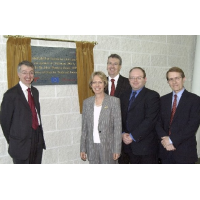InfoLab21 Launch

Last week saw the launch of InfoLab21 - Lancaster University’s world-class research, development and business centre in Information and Communication Technologies.
Picture Caption: Northwest Development Agency Chairman Bryan Gray, Trade and Industry Secretary the Rt. Hon Patricia Hewitt MP, Lancaster University Vice Chancellor Professor Paul Wellings, Neil Clatworthy, representing the ERDF, InfoLab21 Director Professor David Hutchison.
More than 100 delegates attended the launch of the new building, which is home to the Computing Department, the Department of Communication Systems as well as the Knowledge Business Centre and ICT Focus, which provides advanced technical training in IT.
These are just a few of the numerous research projects underway at InfoLab21.
Computing
E-campus project
Recognising the strategic importance of ubiquitous computing as a revolutionary new technology, the university has invested £500k to construct a unique ubiquitous computing infrastructure around the university campus (the eCampus).
Ubiquitous computing is a term used to describe a new approach to using computers in everyday life, from personal computers to tiny embedded devices, all communicating through interconnected networks.
eCampus will provide the department with a totally unique research testbed for large-scale ubiquitous computing systems and should act as a catalyst for the creation of a range of experimental e-Services and inter-disciplinary research (reaching out to disciplines such as Psychology, Engineering, Sociology and New Media).
The first prototype, which will be completed in summer 2005, will comprise of several large-screen public displays placed in the university underpass containing interactive information and New Media artwork. eCampus will become a collective catalyst for interaction and experimentation – extending far beyond existing ubiquitous computing test-beds and enabling researchers at Lancaster to conduct experiments involving a very large user community.
Aspect oriented software development
Lancaster University’s Computing Department is leading a major European software development project that has been awarded € 4.4m – around £3.1m - by the European Commission.
The project, called AOSD-Europe: European Network of Excellence on Aspect-Oriented Software Development, will be funded for four years and brings together 11 leading European organisations - nine academic and two industrial - including universities in Germany, The Netherlands, France, Belgium, Israel, Ireland and Spain, plus Siemens AG, Germany, and IBM United Kingdom Ltd.
Lancaster is at the forefront of research into Aspect-Oriented Software Development (AOSD) – earlier this year the University hosted a five-day international conference on the subject, attended by experts from universities and software companies around the world.
Work applying mobile computing to care in the community
Researchers have developed a new communication system for staff and residents at two residential care homes in Carlisle. The system - which has been running in both staff offices of the housing project since October 2002 - enables staff and residents to send text messages to a single screen in the office. The system has proved to be a popular alternative to the telephone for staff who often find the phone to be engaged. It also brings information together in one place where previously it was scattered on notice boards, answer phones, pagers and diaries.
Researchers plan to refine the system, through further discussion with the staff.
Communication Systems
The TwoDOS disk
The Department of Communication Systems (DCS) is involved, together with 5 partners including Philips Research Eindhoven, HW Communications and universities in Ireland and The Netherlands, in developing a new optical storage disk which will be capable of storing more than ten times the amount of information currently available on a standard CD or DVD.
As digital content, including audio, video and data, increases in size and complexity, the demand for higher capacity portable storage devices with faster access times is also increasing. The classical "Single Track" technology used on all optical storage disks so far seems to have come to an end, both in capacity and data rate due to physical constraints .
The TwoDOS disk incorporates multiple tracks within the broad spiral, which replaces the single track of previous disks, enabling more information to be saved and read.
Researchers working on the EU-funded project are working with blue (instead of red) laser technology to create a disk which will have a capacity of at least 50GB for a 12cm disk; the maximum storage capacity of the 12cm CD and DVD are capable of storing up to only 0.7GB and 4.7GB, respectively.
COMBUS
COMBUS is a DTI-funded project which will use specially-designed sensors on buses to gather and distribute diverse data - from traffic volume to pollution levels - as the bus travels along its usual route.
As the bus stops at one of many ‘hotspots’ or information gathering stations (placed along the bus route) information gathered by the bus will be transferred to a main archive. This data can later be shared with the public via websites or WAP servers.
Bus companies and passengers on the bus will also benefit from the project as an onboard display will provide passengers with location-based information such as local advertising, tourist and travel information. High resolution CCTV cameras installed in the busses as part of the project will also provide better security for passengers and staff.
Remote Medical Telemetry
This project is developing information systems which will enable medical teams to provide support to a patient who may be hundreds of miles away. Remote Medical Telemetry will make it possible for hospital-based doctors can carry out a virtual assessment on patients in isolated areas – for example on a mountain side during a rescue.
Lancaster researchers are working with new technology that allows for photographs, videos, sound and bio –information such as temperature and pulse readings to be transmitted in real time. Sensors attached to the patient’s body can transmit medical information enabling emergency teams to gain crucial minutes.
For more information on InfoLab21 please go to http://www.infolab21.lancs.ac.uk/